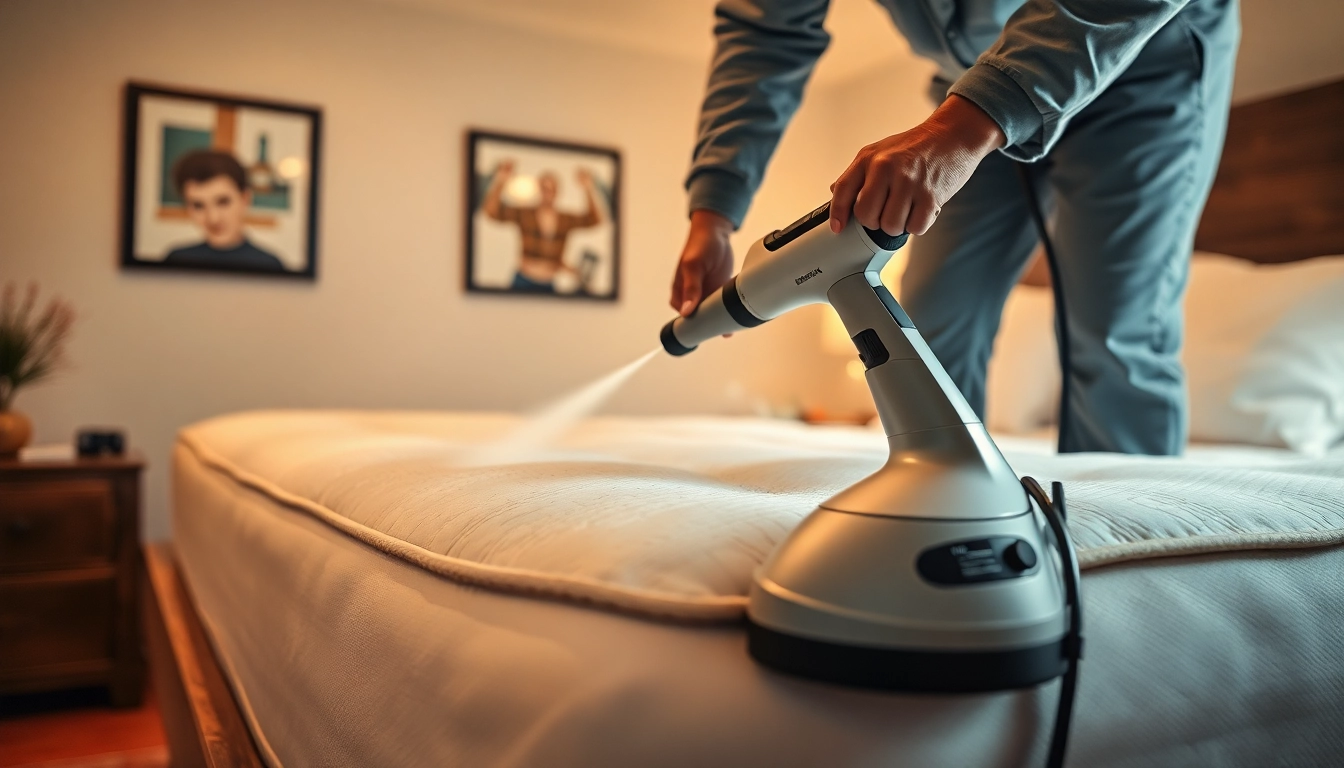Understanding Bed Bugs and Their Impact
What are Bed Bugs?
Bed bugs are small, wingless insects that belong to the Cimicidae family. They are approximately 4 to 5 millimeters long, with a reddish-brown color and an oval shape. Bed bugs are notorious for feeding on human blood, typically while their hosts sleep. Their bites can lead to irritation, allergic reactions, and even secondary infections. Once present, they can multiply quickly, making their removal a daunting task. The resilience and adaptability of bed bugs have made them a significant pest in homes and businesses despite extensive control efforts.
Signs of Infestation
Identifying bed bugs early is crucial for effective treatment. Key signs of a bed bug infestation include:
- Physical Bites: Red, itchy welts on the skin, often grouped in a line.
- Blood Stains: Small brown or red spots on sheets and mattresses from crushed bed bugs.
- Fecal Spots: Dark spots on bedding or furniture, indicative of bed bug excretion.
- Shed Skins: Exoskeletons left behind as bed bugs grow.
- Odor: A musty, sweet smell in heavily infested areas due to bed bug pheromones.
If any of these signs are noticeable, prompt action is essential to prevent the infestation from getting worse.
The Psychological Effects of Bed Bug Infestations
The presence of bed bugs can lead to more than just physical discomfort. The psychological effects are profound and can include:
- Stress and Anxiety: Constant worry about bites can lead to sleep disturbances and anxiety disorders.
- Embarrassment: Many people feel ashamed to admit they have an infestation, which can lead to isolation.
- Depression: The stress of dealing with an infestation can lead to feelings of hopelessness and depression.
Understanding these effects is vital when dealing with bed bug removal since an integrated approach is necessary to address both the physical and emotional repercussions.
Effective Strategies for Bed Bug Removal
DIY Bed Bug Removal Techniques
Many homeowners seek to handle infestations themselves before calling in professionals. Some effective DIY techniques include:
- Steam Cleaning: Bed bugs are sensitive to heat. Steam cleaning surfaces and fabrics at a temperature above 130°F (54°C) can effectively kill them.
- Washing Fabrics: Wash bedding, clothing, and any other fabric in hot water to eliminate bugs and eggs. Drying on high heat is also crucial.
- Vacuuming: Vacuuming carpets, floors, and furniture helps to physically remove bugs and their eggs. Make sure to dispose of the vacuum bag properly.
- Diatomaceous Earth: Sprinkling food-grade diatomaceous earth in affected areas can help dehydrate and kill bed bugs.
While these methods can be effective, they require diligence and commitment to achieve satisfactory results.
Professional Extermination Options
For severe infestations, professional pest control services may be necessary. Professional extermination options typically include:
- Heat Treatment: This method employs specialized equipment to raise the temperature in infested areas, effectively killing bugs at all life stages.
- Chemical Treatments: Exterminators often use pesticides that are less harmful than those available to the public, specifically formulated to target bed bugs.
- Integrated Pest Management (IPM): This holistic approach combines inspection, monitoring, and treatment strategies and focuses on long-term prevention.
Each method has its benefits and potential drawbacks, and a professional can evaluate which approach best suits your specific infestation.
Integrating Heat Treatment and Chemical Solutions
The most effective pest control strategies often involve a combination of methods. Integrating heat treatment with chemical solutions can enhance effectiveness:
Heat treatment can eliminate bed bugs and their eggs, while chemical treatments can cover less accessible areas where bed bugs might hide, such as inside walls and furniture. This dual approach ensures comprehensive coverage, addressing both visible and hidden infestations.
Preparing Your Home for Bed Bug Treatment
Steps to Take Before Treatment
Proper preparation is key to ensuring that treatments are effective. Here are essential steps to follow before bed bug treatments begin:
- Remove Clutter: Declutter your home to make treatment easier and more effective.
- Isolate Infested Items: Seal infested bedding and clothing in plastic bags to prevent the spread of bed bugs.
- Communicate with the Exterminator: Provide detailed information about the infestation to help the exterminator prepare an effective treatment plan.
Essential Items to Have on Hand
Before the treatment begins, ensure you have the following items ready:
- Plastic Bags: For sealing contaminated items.
- Protective Gear: Gloves and masks can protect you during DIY treatments.
- Cleaning Supplies: Laundry detergent, vacuum cleaner, steamer, and diatomaceous earth for initial clean-up.
Cleansing Your Environment Post-Treatment
After the extermination treatment, maintaining cleanliness is crucial to prevent re-infestation. Consider these tips:
- Regular Vacuuming: Vacuum regularly to capture any bed bugs that may have survived initial treatment.
- Wash Fabrics Frequently: Continue washing bedding and clothing often in hot water.
- Monitor for Signs: Keep an eye on any signs of re-infestation and act quickly if they appear.
Cost Considerations for Bed Bug Removal Services
Average Costs of Professional Treatments
The costs for professional bed bug removal vary widely depending on several factors, including the extent of the infestation and the type of treatment selected. On average, a professional treatment can cost between $300 to $1,500, depending on:
- The size of the infestation
- The treatment method
- Geographical location
Factors Influencing Treatment Prices
Several factors influence the overall treatment costs:
- House Size: Larger homes often incur higher treatment costs.
- Infestation Severity: More severe infestations require more intensive treatment methods.
- Follow-up Services: Some services include follow-up visits, increasing total costs but improving effectiveness.
Affordable Alternatives for Bed Bug Extermination
For those on a tight budget, there are affordable alternatives to professional services:
- DIY Techniques: As discussed, methods like steam cleaning and vacuuming can be effective.
- Community Resources: Some local health departments offer free or low-cost services for pest control.
- Payment Plans: Some pest control companies provide financing options to spread out treatment costs.
Preventing Future Bed Bug Infestations
Best Practices for Home Hygiene
Preventing bed bug infestations requires vigilance and proper home hygiene. Recommended practices include:
- Regular Inspections: Frequently check for signs of bed bugs, especially after traveling.
- Declutter Regularly: Keeping your home clutter-free minimizes hiding spots.
- Safe Storage: Utilize sealed plastic bin storage for rarely used items.
Travel Tips to Avoid Bringing Bed Bugs Home
To prevent bringing bed bugs home after traveling, consider the following tips:
- Inspect Accommodations: Check hotel rooms for signs of bed bugs before unpacking.
- Use Luggage Protectors: Store luggage on hard surfaces and not on beds or carpets.
- Wash Clothing Immediately: Upon returning home, wash your clothes in hot water and dry them on high heat.
Regular Inspections and What to Look For
Conduct regular inspections of your home, specifically focusing on:
- Bed Frames and Mattresses: Look for fecal spots, shed skins, and live bugs.
- Furniture: Check seams and crevices for signs of infestation.
- Upholstered Chairs and Couches: Inspect folds and under cushions.
By being proactive and knowledgeable about bed bugs, you can significantly decrease the likelihood of an infestation and navigate the challenges of Bed Bug Removal effectively. Understanding the behaviors and signs associated with bed bugs, coupled with effective removal strategies and ongoing preventive measures, can help protect your home from future infestations.



